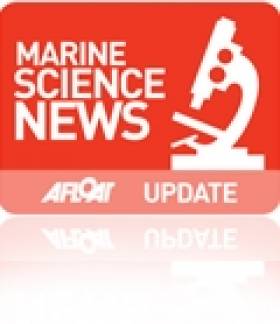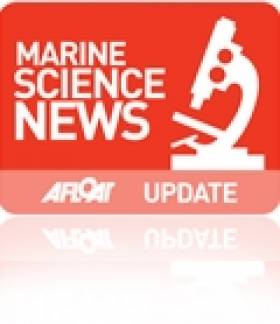Displaying items by tag: science
Irish Marine Scientists Investigate Canyon's Biodiversity
#MARINESCIENCE – A team of Scientists led by Dr. Louise Allcock, NUI Galway set sail onboard the RV Celtic Explorer 13th April 2012 to investigate biodiversity on the Whittard Canyon System.
Whittard Canyon is a huge canyon system that spans Irish, UK and French waters along the Atlantic margin. This survey will take place in the Irish territory where the Continental shelf drops down to depths beyond 3000 m. The Marine Institute's Holland 1 Remotely Operated Vehicle (ROV) will be deployed to explore the steep canyon walls where biodiversity is greatest because of the fast currents there. Whittard has been explored before, but the system is so vast that some areas are still unsurveyed.
The multidisciplinary team on board will be looking for corals and sponges, which can be found in extensive reefs at some depths. A feature of species growing attached to the seafloor is the production of chemicals, thought to deter grazing and overgrowth by other animals. There is significant scientific and commercial interest in the novelty of these chemicals for medical applications. Material previously collected for the Irish Marine Biodiscovery Programme has shown activity against some cancer cell lines, the first step in potentially developing new treatments. Material collected on this cruise will be examined in antibacterial and anti-cancer assays as part of the National Marine Biodiscovery Programme in NUI Galway, UCC and the Marine Institute.
The survey will also carry out detailed surveys of the canyon system in collaboration with onboard taxonomists from across Europe, who are experts in identifying deep sea marine organisms. Biogeochemists from Trinity College Dublin will study the processing of material in the benthic ecosystem, with oceanographers from Galway following the transport of sediment and planktonic production to deeper waters. These studies will improve the understanding of the canyon ecosystem and the links between surface and deep waters.
The scientists will be blogging throughout the survey (13th - 29th April) and you can follow their progress here.
This research survey and the Beaufort Marine Research Award are carried out under the Sea Change strategy with the support of the Marine Institute and the Marine Research Sub-programme of the National Development Plan 2007–2013. The Beaufort award in Marine Biodiscovery is a consortium between NUI Galway, UCC and Queen's University Belfast.
The Ship-Time Programme provides access to the National Research Vessels (Celtic Explorer / Celtic Voyager) for research organisations based in Ireland.
Coveney to Address Malahide 'Marine Economy' Conference
#MARINE – Simon Coveney, T.D., Minister for Agriculture, Food and the Marine will be a keynote speaker at 'The Atlantic Area Conference, the Marine Economy' – a key component of the EU Integrated Strategy for the Atlantic Area", hosted by the Border, Midland and Western Regional Assembly on 7th February 2012. will provide a unique opportunity to inform the various stakeholder groups on the European Union Strategy for the Atlantic (EUSA) which was officially launched in Lisbon (Portugal) on 28th November 2011.
Keynote speakers will include: Mr. Simon Coveney, T.D., Minister for Agriculture, Food and the Marine; Mr. Matthew King, Head of Unit, Maritime Policy for the Atlantic Space, DG MARE, European Commission. Other speakers will include representatives from the Atlantic Area Programme Managing Authority, the Conference of Peripheral Maritime Regions (CPMR), the Marine Institute and a selection of Atlantic Area approved marine projects.
Presentations will outline the aims and objectives of the Atlantic Strategy as a mechanism to support growth and job creation through the sustainable development of our shared Atlantic marine resources.
'The Sea: One of Ireland's Greatest Natural Resources' - Coveney
The Minister was speaking during a visit to the Marine Institute's research vessel, RV Celtic Explorer, on its return from a mission to the Labrador and Newfoundland Seas.
He added "I am particularly pleased that this is my first official engagement as Minister for Agriculture, Marine and Food. The work of the RV Celtic Explorer highlights the essential nature of marine research, development and sustainable management, through which Ireland is developing a strong and well-deserved reputation as an emerging centre of excellence, where we have prominent roles in many European and international marine science bodies."
Minister Coveney commended the Marine Institute and its Chief Executive, Dr Peter Heffernan, for its leading and proactive role in the areas of fisheries science, marine environment and food safety as well as ocean science and said that he looked forward to working closely with the Institute and benefitting from the research and advice which they would undertake and provide.
The Minister noted that Ireland's two national research vessels – RV Celtic Explorer and RV Celtic Voyager – will record 267 days at sea during 2011, during which they will be engaged in fisheries surveys, underwater mapping, climate studies and deepwater surveys.































































